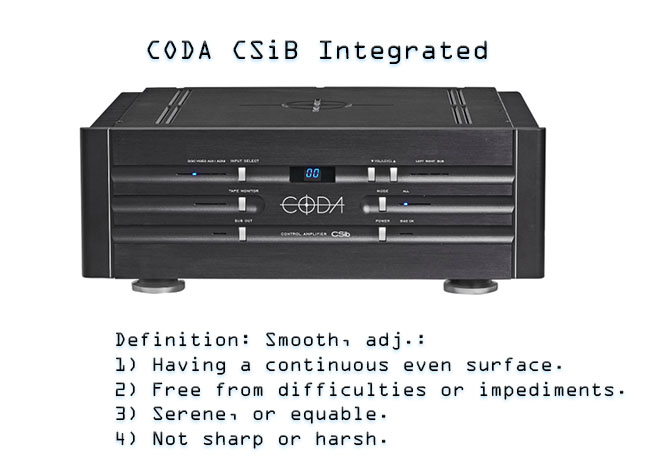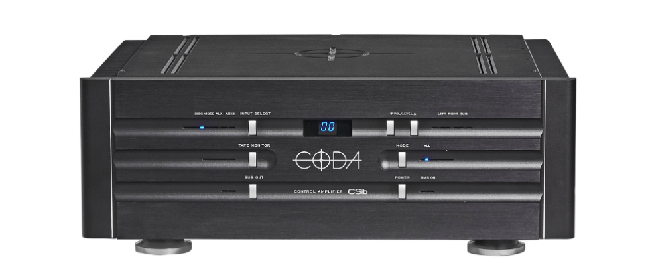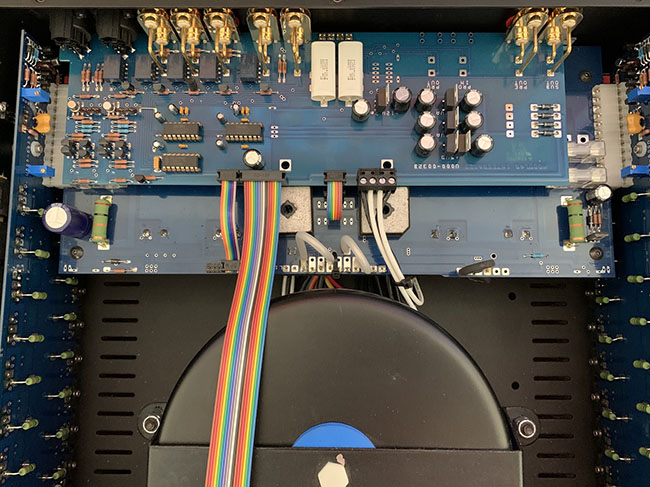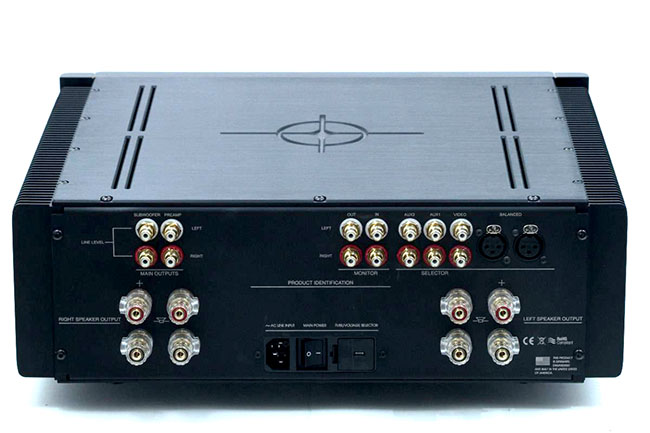Coda CSiB Integrated by Richard Willie

 If there were an appropriate one-word description of the Coda Technologies CSiB, “smooth” would be it. Though smooth is the word that stands out in my mind when thinking about the Coda CSiB, it is multifaceted in its approach to sound. The Coda doesn’t sound like a tube amplifier. Still, it exhibits some of the best characteristics of tube amplifiers in terms of tonal color, realistic reproduction of voices, and the way that music seems to ooze from the speakers effortlessly; at the same time, it doesn’t sound like many other solid-state amplifiers either, but it does have an incredible amount of detail, outstanding dynamics, and what sound like limitless power reserves. In short, the CSiB has proven itself to be one of the finest amplifiers (integrated or separate) that I’ve had the chance to audition.
If there were an appropriate one-word description of the Coda Technologies CSiB, “smooth” would be it. Though smooth is the word that stands out in my mind when thinking about the Coda CSiB, it is multifaceted in its approach to sound. The Coda doesn’t sound like a tube amplifier. Still, it exhibits some of the best characteristics of tube amplifiers in terms of tonal color, realistic reproduction of voices, and the way that music seems to ooze from the speakers effortlessly; at the same time, it doesn’t sound like many other solid-state amplifiers either, but it does have an incredible amount of detail, outstanding dynamics, and what sound like limitless power reserves. In short, the CSiB has proven itself to be one of the finest amplifiers (integrated or separate) that I’ve had the chance to audition.
Description
The Coda Control Amplifier C-Series Integrated Balanced (“CSiB”) is an Integrated Amplifier that is outwardly designed in much the same way as its predecessors. Inwardly, the CSiB received the same transistor upgrades as the No. 8 amplifiers that resulted in a drastically lowered noise floor and improved S/N ratios. The CSiB amplifier section is identical to the Coda No. 8 amplifier, which was reviewed to much acclaim by Terry London in 2018. The preamplifier section is based on the same circuit topology as the Coda 07x Preamplifier, also very well regarded.

In terms of craftsmanship, the CSiB stands as one of the more carefully and meticulously assembled products I have come across. Prior to reviewing the CSiB, I discussed the general quality of Coda products with a couple of industry professionals. The quality of the Coda products internals (as described to me) was immaculate and exceeded typical hi-fi industry standards. With my curiosity piqued by these assertions, one of the first things I did after taking the CSiB was open the top to have a look. While I am not an electrical engineer by trade, I can recognize quality craftsmanship in electronics; here, the quality was remarkable. It was as if the internals of the CSiB were meant to be on display as much as the outer components. The sound reflects this attention to detail.


The amplifier’s back is adorned with all the usual accouterments of an integrated amplifier of this class. The CSiB comes with one set of balanced inputs and three sets of unbalanced inputs. A somewhat uncommon (but much appreciated) addition for an integrated preamplifier was a set of line-level outputs and subwoofer outputs. The CSiB sports two sets of output binding posts per channel, which can be used for a bi-wire configuration for speakers or running high-level inputs to a pair of subwoofers. I typically use Kimber Monocle speaker cables with WBT Spade terminations; I found the WBT binding posts used on the CSiB to be a perfect fit for these terminations. In all, the inputs and outputs on the CSiB had all the bases covered.
When I spoke to Coda Technologies President Doug Dale about voicing the CSiB amplifiers, he said that the Coda engineers uniformly agree that Class A output stages sound more natural and pleasing to the ear. Dale explained that many acoustic instruments produce even ordered harmonics above the fundamental frequency, and Class A amplification is similar in the way it has primarily even-ordered harmonics above the fundamental. In contrast, Class A/B amplifiers typically produce odd-ordered harmonics, which can be perceived in several different ways, but often as “less pleasing” to the ear. Consider the difference between a flute with primarily even-order harmonics and an accordion with primarily odd-ordered harmonics. The flute will typically be characterized as warm and pleasing, while the accordion will be characterized as well – an accordion. So goes the difference between Class A and Class AB amplification, though to a less dramatic degree.
Class A integrated amplifiers have a reputation for running hot and driving up the electric bill. Despite this reputation, I found the heat output and power usage of the CSiB to be very reasonable for an integrated amplifier with a 12-watt Class A envelope. When fully warmed up, its heat sinks are warm enough to let you know it’s running but not uncomfortable to touch. Many may conclude the CSiB is an excellent candidate to keep warmed and ready all of the time.
One of the striking qualities of the CSiB is the effortlessness of its presentation, which can largely be traced to its massive power reserves. From the power supply to the output devices, the CSiB is the epitome of being “overbuilt.” The CSiB power transformer is rated at 3.0 kVA, then coupled to an 80,000μF capacitor filter bank. The output stages use 20 output devices for each channel, with a combined output rating of 4,000 watts and over 125 amps.
 Like the No. 8, the Coda CSiB comes in three different variants with differing levels of Class A bias and maximum outputs, aptly named V1, V2, and V3. I am reviewing V2 of the CSiB, which has a Class A envelope of 12 Watts, and maximum power ratings of 250 watts at 8 Ohms, and 500 watts at 4 Ohms. However, after speaking to Doug Dale, perhaps one of the most impressive feats of the CSiB (and its robust power supply) is its ability to not only double its power output from 8 Ohms to 4 Ohms but again into 2 Ohms!
Like the No. 8, the Coda CSiB comes in three different variants with differing levels of Class A bias and maximum outputs, aptly named V1, V2, and V3. I am reviewing V2 of the CSiB, which has a Class A envelope of 12 Watts, and maximum power ratings of 250 watts at 8 Ohms, and 500 watts at 4 Ohms. However, after speaking to Doug Dale, perhaps one of the most impressive feats of the CSiB (and its robust power supply) is its ability to not only double its power output from 8 Ohms to 4 Ohms but again into 2 Ohms!
My reference speakers for this review are the Tekton Design Double Impacts. While these speakers are very sensitive, they are somewhat known for sounding better with “high-current” amplifiers. The CSiB has brought my Double Impacts to life in ways that other amplifiers have not; I would wager there are very few speakers out there that the Coda CSiB will not handle with ease.
Break-In
Break-in is always an interesting phenomenon in high-end audio. Experience says that it’s something to be aware of when listening to new equipment, but at the same time, no two pieces of equipment are quite the same.
In terms of break-in, the CSiB was on the more subtle end of the spectrum. When I agreed to take the Coda CSiB in for review, Doug Dale waited for several days after the unit had been manufactured before sending it to me. Coda has a mandatory burn-in policy before products leave the floor, which helps cut down the consumer side’s burn-in process. In my recent review of the PS Audio M1200 monoblock amplifiers, I noted the highly long break-in period before the amplifiers sounded “right.” The Coda CSiB was utterly different. Right out of the box, it sounded great, and although it did improve slightly with time, it wasn’t nearly as dramatic as other amps I’ve heard.
Listening
 The stated objective of the CSiB is to provide the performance of separates in an integrated amplifier which, in this case, appears to have been a resounding success. Functionally, the CSiB is a 07x FET preamplifier housed within a No.8 chassis, both of which are extremely well-regarded in their own right. The CSiB offers virtually all of the benefits of each of these products, with few (if any) of the pitfalls of an integrated amplifier.
The stated objective of the CSiB is to provide the performance of separates in an integrated amplifier which, in this case, appears to have been a resounding success. Functionally, the CSiB is a 07x FET preamplifier housed within a No.8 chassis, both of which are extremely well-regarded in their own right. The CSiB offers virtually all of the benefits of each of these products, with few (if any) of the pitfalls of an integrated amplifier.
As already alluded to, one of the hallmarks of the Coda CSiB is its smoothness and liquidity. There is an effortless and natural purity to the presentation of music that makes it sound like a fog has been lifted from the music. Timbres and tonality are greater exposed; instruments and voices are much easier to distinguish from one another; above all, the music simply flows.
Detail retrieval is excellent without ever being etched, harsh, or overly analytical. Many amplifiers can retrieve incredible amounts of detail, but frequently, it comes at the expense of sounding overly etched, grainy, or sibilant. This is simply not the case with the Coda. Not only does it retrieve aspects of familiar recordings (as the wearied expression goes) that I have never heard before, but it does so with a complete lack of harshness or glare. The Coda simply seems to bring the music “closer” to the listener.
The three-dimensional renderings of music are no less remarkable. The CSiB casts one of the largest and most precise soundstages of any Preamp/Amplifier combo I have heard without qualification. Even casualties of the so-called “loudness wars” have more depth and layers than I am accustomed to hearing. I find myself doing the “scary real” double-take more frequently than ever when little noises and sounds within recordings pull off that “real life” sound.
The bass and macro dynamics of the CSiB are excellent while still sounding natural. Often an amplifier that nails macro-dynamics misses the boat on other aspects of the sound. For example, an audio designer might juice the negative feedback to get an iron grip on the bass, but this may come at the expense of sounding dry and “overdamped” everywhere else. The Coda manages to introduce prodigious bass into the equation without becoming a one-trick pony. Bass is full and satisfying while preserving the beautiful timbres, details, and emotion of the recording.
These descriptions of the Coda are intangible, but the least precise of these is “magic.” It’s hard to quantify or describe, but a magical-sounding piece of gear is immensely difficult to stop listening to, both relaxing and interesting at the same time. On some level, I believed that “magic” was the warm euphonic distortion that so many of my favorite amplifiers produced. However, the Coda tends to be more neutral in its sound than many of the amplifiers I love, yet it still has that magical quality to its sound. I still haven’t quite found the words to describe what a “magical” amplifier sounds like, but I know it when I hear it, and the Coda CSiB has “the magic.”
Perhaps one of the most impressive characteristics of the CSiB was its ability to perform well with almost any program material. My review process generally crosses virtually every musical genre at some point. Often, I find that an amplifier seems to play a particular style of music more enjoyably than others (e.g., X amplifier is good if you like jazz, but Y amplifier is excellent if you listen to pop music). But here, I feel that I could have pulled a panel of classical, jazz, electronic, rock, pop, country, or hip hop tracks and arrived at the same conclusions. From the tonal richness, color, and honesty of the Marc Vallée Trio, to the highly processed electronic music of Chaz Bear, the CSiB performed extremely well no matter the music involved. The three samples below are simply “data points” in the review analysis.
“Not all recordings are created equal. The Marc Vallée Trio’s release of Hamadryade (so named after the Greek deity of the woods), released by Fidelio Audio, is what I would characterize as a “classic audiophile recording.” The tonal colors, detail, and sense of space are quite remarkable, with an overall feeling of richness and depth. If there was ever a recording that a new piece of equipment could dig “new details” out of, it’s this one. For example, I have heard the track “Lights of Barcelona” many times before, but with the CSiB, I noticed “new details” I had never heard before. In the opening of the track, I have traditionally listened to what I thought was the crash of a gong but never paid much more attention than that. Listening to this recording on the CSiB was the first time I noticed the ringing gong was not a single strike but a buildup of smaller strikes that occur over a much more extended period than I had supposed. While these details weren’t exactly obscured or inaudible with my other equipment, the CSiB beautifully delineated each of the taps of the gong in a way that I had simply never heard before.
 The next track, on LP’s 2016 album, “Lost on You,” released by Vagrant Records, is not what I had envisioned myself writing about when I started this review but is significant because it was while listening to it that I realized my reference system was going to change. Unlike Hamadryade above, Lost on You is not an “audiophile classic” per se but remains part of my portfolio of test tracks. The blues-influenced opening track, Muddy Waters, features Laura Pergolizzi’s vocals floating over a choral backup reminiscent of gospel music, built on a solid foundation low-frequency synth pulses. Through the CSiB, the deep rolling synth-generated bass in the opening bars of the track sound somewhere in the Goldilocks zone of “just right,” and the vocals are portrayed with a beautiful natural sheen. Although I have listened to this track with other pieces of equipment, the CSiB brought this track to life in a way that the others could not.
The next track, on LP’s 2016 album, “Lost on You,” released by Vagrant Records, is not what I had envisioned myself writing about when I started this review but is significant because it was while listening to it that I realized my reference system was going to change. Unlike Hamadryade above, Lost on You is not an “audiophile classic” per se but remains part of my portfolio of test tracks. The blues-influenced opening track, Muddy Waters, features Laura Pergolizzi’s vocals floating over a choral backup reminiscent of gospel music, built on a solid foundation low-frequency synth pulses. Through the CSiB, the deep rolling synth-generated bass in the opening bars of the track sound somewhere in the Goldilocks zone of “just right,” and the vocals are portrayed with a beautiful natural sheen. Although I have listened to this track with other pieces of equipment, the CSiB brought this track to life in a way that the others could not.
If there is one thing I learned throughout the review process, the CSiB gets along just fine without subwoofers. Toro y Moi’s Outer Peace album, released by Carpark Records, is only a couple of years old but has received a fair amount of air time in my household ever since my daughters and I heard it playing over the radio while out to dinner. “Freelance” is a favorite track from that album, and I have to admit that the lyrical nod to Ugly Casanova’s 2002 “Hotcha Girls” makes me smile every time I hear it (Ugly Casanova being Isaac Brock’s side project to experiment outside the confines of Modest Mouse). “Freelance” at its core is an electronic-dance track with an unmistakable disco flow, and complete with a heavy bassline throughout the entirety of the track (and realistically, the entire album). What struck me was how little the CSiB benefitted from additional subwoofers in the mix; subwoofers could undoubtedly thicken the bass, help with some spatial cues, and perhaps warm the music’s tone at no point did I feel they were needed. I spent most of my listening time with the subwoofers off – not feeling that anything was missing. The CSiB simply pressurized the room in exactly the way I would imagine the artist wanted it.
Comparisons
 The principal point of comparison for this review is the Pass Labs XA30.8, which has a very well-documented voice. The Pass Labs XA30.8 has been my reference for several years now, with good reason. A quick search of the Pass Labs XA30.8 will reveal a set of glowing reviews that are almost uniformly outstanding, which helps to punctuate the significance of how the Coda outperforms the XA30.8.
The principal point of comparison for this review is the Pass Labs XA30.8, which has a very well-documented voice. The Pass Labs XA30.8 has been my reference for several years now, with good reason. A quick search of the Pass Labs XA30.8 will reveal a set of glowing reviews that are almost uniformly outstanding, which helps to punctuate the significance of how the Coda outperforms the XA30.8.
Starting at the top of the frequency spectrum and down into the midrange, the Coda CSiB and Pass Labs XA30.8 are both similar and remarkably different at the same time. Since the CSiB is an integrated amplifier, direct comparisons to its amplifier section were not possible. That said, most of the volume control on my system comes through the PS Audio Directstream DAC. I found the closest comparison was setting the preamplifier stage on the Coda to unity gain and connecting the DAC directly to each, rather than use an intermediary preamplifier.
The first difference I noticed between the Coda and the Pass was how much smoother the Coda sounded. I have never regarded the Pass Labs XA30.8 as sounding “grainy,” but after becoming accustomed to the sound of the Coda, that’s exactly my perception of the XA30.8’s comparative sound. After extended listening sessions and becoming fully accustomed to the Coda, the XA30.8 seems to have a slight grain that sits as a layer over the rest of the music. However, this is ONLY in comparison to the Coda, and not necessarily other amplifiers. Additionally, the XA30.8 seems to have a slightly greater degree of sibilance than the Coda CSiB. While this is not a huge issue, it does rear its head on certain kinds of music (especially loud passages).
Another point of difference between the two amplifiers is the warmth and euphonic distortion. Despite being a little more sibilant than the Coda, the XA30.8 is a little warmer and sweeter in tone, and the sound seems to be just a tad thicker through the low mid-range frequencies. Comparatively, while I wouldn’t characterize the Coda CSiB as being perfectly neutral in terms of warmth, it’s closer to neutral than the Pass Labs XA30.8. Where the XA30.8 seems to imprint a bit of itself into every piece of music, the Coda CSiB is clear, pure, natural-sounding, and is better at communicating accurate colors and timbres within the recording.
The bass range is where the Coda and Pass Labs differentiate a bit more. Although I have almost always felt that the Pass Labs XA30.8’s bass was “good,” it always seemed to be tracing the low bass’s outlines. Switching to the CSiB reveals a completely natural and effortless presentation of the bass; where the XA30.8 outlines the bass, the CSiB fully fleshes it out with a comparatively robust command of these frequencies.
I also had the opportunity to directly compare the CSiB with the PS Audio M1200 monoblock amplifiers during the review period. The M1200’s had a much higher damping factor and “grip” on the woofers compared to the CSiB. This made bass through the M1200’s seem to have a higher degree of resolution, creating a deep cavernous sound when the program material called for it. But the gains in the bass region were lost in the mid and high frequencies, where the CSiB was the clear winner. Even though the M1200’s and the CSiB were comparable on simple detail retrieval, the CSiB was incredibly smooth in comparison and brought out the tones and colors of the music in ways that the M1200’s could not.
Conclusion

As mentioned above, one of the stated goals of the CSiB is to achieve a “true separates” performance in an integrated amplifier. Generally, in the world of hi-fi audio, integrated amplifiers don’t quite measure up to their separate preamplifier/amplifier counterparts. Compared to what I have been using as a reference, I would say the Coda CSiB not only measures up but outperforms in many respects.
I have typically gravitated to “warmer” toned equipment and my initial apprehension with Coda equipment centered on the fear that it would be “too neutral” for my tastes. I have traditionally heard the best color, timbres, and tone come from equipment of a slightly warmer hue and concordantly associated “neutral” with washed-out tones. The Coda was a revelation because it divorced these qualities to a certain extent and filled my listening space with a liquid, transparent, colorful, dynamic, and beautifully three-dimensional sound.
Am I keeping the Coda CSiB as my reference? No… but for one simple reason. As much as I love the CSiB, it makes reviewing “separates” challenging since I cannot separate the preamp and amplifier sections. In terms of performance, I have no doubt the CSiB is holistically a reference-level integrated amplifier. I love the sound of the CSiB and really don’t want to change a thing. Doug Dale assures me that the FET 07x Preamplifier and No. 8 Amplifier combination are very close in sound to the CSiB (if not identical). A set is on the way to me now.
I hope to report briefly on that next!

Richard Willie

Specifications:
Price:$6500
400 Watts per channel into 8 Ohms
800 Watts per channel into 4 Ohms
Class A operation to 5W
State-of-the-art, remote-controlled “separates” performance with the added benefit of balanced audio inputs for even greater audio quality.
Preamplifier section derived from the Coda 05X design, utilizing the PGA2320 digitally-controlled precision analog attenuator.
Component upgrades include PRP audio resistors, Black Gate and Multicap capacitors, and high-speed rectifiers for the preamp power supply
Coda CSX Precision Bias Class A/AB amplifier design, with discrete JFET differential input stage, VMOSFET voltage gain DC coupled to an ultra-wideband bipolar output stage.
Fully discrete amplifier FET differential input stage DC coupled to an ultra-wideband bipolar output stage
No overall feedback
Separate tape monitor and processor loops
Stereo subwoofer output
Wideband, fully-regulated power supply with EMI and RFI line filtering
10-year warranty / 5-year transferable
Designed, manufactured and assembled in the USA
Website: www.coda.cc/product/
Stereo Times Masthead
Publisher/Founder
Clement Perry
Editor
Dave Thomas
Senior Editors
Frank Alles, Mike Girardi, Russell Lichter, Terry London, Moreno Mitchell, Paul Szabady, Bill Wells, Mike Wright, and Stephen Yan,
Current Contributors
David Abramson, Tim Barrall, Dave Allison, Ron Cook, Lewis Dardick, John Hoffman, Dan Secula, Don Shaulis, Greg Simmons, Eric Teh, Greg Voth, Richard Willie, Ed Van Winkle, Rob Dockery, Richard Doran, and Daveed Turek
Site Management Clement Perry
Ad Designer: Martin Perry







Be the first to comment on: Coda CSiB Integrated by Richard Willie